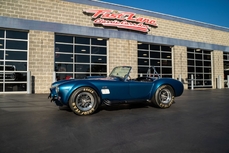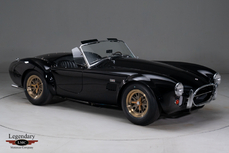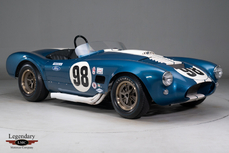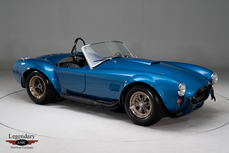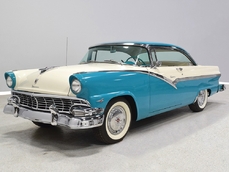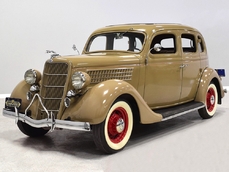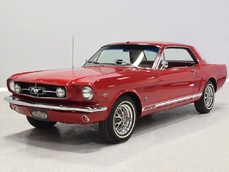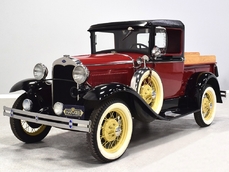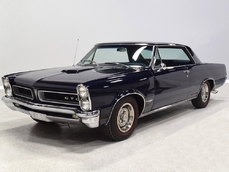Shelby Cobra 427 427 cubic inch V8 1965
General description :
The Shelby Cobra is the most imitated car of all time. From the dozens (hundreds?) of replica manufacturers to the Dodge Viper, putting a big engine in a small roadster has been a major industry for decades. With real Cobras easily bringing $1 million or more on a routine basis, the replica market has exploded and they’ve become a thing unto themselves, built to suit each individual owner and capable of more performance and speed than any stock original Cobra could imagine.
But if you want the real experience, the feeling that guys had in 1964 when they drove their new Cobras off the dealer lots, there aren’t many choices. A replica Cobra isn’t necessarily an accurate Cobra. Which is where Peter Bayer and Contemporary Classic Motorcars comes in. One of the earliest Cobra replica builders, Contemporary set out to build an affordable alternative to the original, which even in the early 80s was seeing skyrocketing values. Peter Bayer, founder of Contemporary, owned Shelby Cobra CSX3045, a real-deal Cobra, and used that as the blueprint for his replicas. As a result, the Contemporary Cobras are arguably the most accurate replicas ever made, right down to the round tube frames and body molds pulled directly from CSX3045. Today, Contemporary Cobras have become collectors’ items in their own right, representing an uncompromising look at Shelby Cobra building and an authentic experience.
Which brings us to this beautifully built Contemporary Cobra, CCX-33111. This is not a homemade car, but a professionally built Cobra that was assembled and finished with an almost fanatical devotion to originality. It’s powered by a 1965 Ford 427 side-oiler, it has an NOS Toploader 4-speed, and even things like the carburetors and oil pan are NOS Ford parts for a real Cobra. The kit was purchased in 1985 from Russell’s All Custom Engineering in Pomona, California in 1985 by SAAC member Vince Marcy, who used all the Shelby Club’s resources to finish construction. It was completed in 1988 and driven about 1000 miles, but for reasons unknown, it was stored until 1999. Today it shows just 1244 miles, and that’s since it was completed, so it remains in exemplary condition. The fiberglass bodywork is smooth, clean, and devoid of cracks or other issues. The bright Candyapple Red paint with Wimbledon White stripes has a brilliant shine and no evidence that it is now nearly 35 years old. Finish quality is worlds better than you would expect of a replica, with excellent gaps and a huge amount of time invested in getting the panels as smooth as possible. There’s simply not a ripple or wave anywhere on the car and its gentle use and careful storage is reflected in every aspect of the car.
Accurate details abound, including the shape of the car itself. Up front, you’ll note a low-mounted oil cooler, a set of chrome bumperettes, and Lucas-style parking lights. The hood shows proper rivets holding the support brace and scoop in place. Racing-style mirror and wind wings are NOS pieces purchased from a Ford dealer. And, of course, no Cobra is complete without a flip-up gas cap. You will also find correct Cobra badges, a single chrome roll hoop, and unusual rectangular taillights that were unique to the SC cars.
Climbing into the cockpit is to travel in time back to 1965. The buckets are finished in black leather, not vinyl, for a correct look and feel and they really are quite comfortable. The shifter is a Mustang unit that’s flipped backwards for that unique forward-canted look, and the steering wheel, while perhaps a little thicker than 1965, looks quite convincing with its AC horn button (not Cobra) which suggests that details were very important to the builder. Smiths gauges are used in the dash, although they’re not quite exact replicas of the original reverse-rotation units but they’re quite attractive (reproduction reverse-rotation gauges are available today). Toggle switches handle the basics, there’s a pushbutton starter on the left, and nobody even thought about adding a radio or heater. For safety there are 5-point harnesses for both driver and passenger, as well as a fire extinguisher mounted to the forward edge of the transmission tunnel. The carpets, side panels with map pockets, and vinyl dashboard are all in excellent condition with zero signs of use or wear. Even the trunk is neatly finished with a set of matching carpets, along with the fuel pump and remote battery. There is no top, but if you’re using your Cobra correctly, you won’t need one.
The engine is a correct 1965 date-coded 427 cubic inch Ford V8, and it is a correct “side oiler” as used in the original Cobras. It was purchased from Ford Power Parts in Norwalk, California in 1984 and was more recently rebuilt in 2001 by Duffee Motorsports in Phoenix, Arizona. While they worked to keep the external look very much as it would have been in 1965, the internals have been upgraded with a full roller valvetrain, MSD ignition system (concealed in the original distributor) and pump-gas-friendly compression ratio. On top there are a pair of correct vintage 600 CFM Holley 4-barrel carburetors on a mid-rise tunnel ram intake, and they’re beautifully tuned so it starts quickly and idles well. Other correct details include NOS “pentroof” valve covers, a Ford expansion tank, and the round air cleaners on top of the carbs. A Ron Davis aluminum radiator is cooled by a massive electric fan with shroud, so it keeps its cool far better than the original setup. Build photos show twin pusher fans in place when it was completed, but since this car lived in California and Phoenix all its life, keeping it cool was critical. Today it runs ice cold and you should have no fears of running this Cobra at speed or sitting in traffic—it doesn’t care. A modern alternator, water pump, and upgraded plug wires help with reliability without notably compromising the original look.
Contemporary also insisted on an original-style round-tube chassis which few replica builders are using today. The front and rear suspension are Jaguar E-Type, which isn’t quite authentic but makes parts and tuning easy and the infinite adjustment of the Jaguar’s torsion bar front suspension is ideal for setting the car up for performance. Koni shocks all around help keep it buttoned down, yet it rides rather well thanks to Jaguar’s incomparable tuning. It sits low, as a Cobra should, but ride quality isn’t at all harsh. The transmission is an NOS Toploader 4-speed manual that was sourced from another Ford dealer, and you’ll note that even the oil pan is a correct NOS piece that was acquired at great expense from a vendor in Wisconsin (we have the receipt). Accuracy was extremely important here. The Jag’s rear end has 3.54 gears inside, so this Cobra is very street-friendly and the hugely powerful 427 doesn’t ever lack for acceleration in any gear. Jaguar brakes are powerful and easy to service, with the inboard rear discs providing a nice performance advantage. The exposed side pipes have racing mufflers built in, so it sounds like a Cobra but doesn’t make your ears bleed, and they’ve been ceramic coated satin black for a brutal, race-ready look. True knock-off Halibrand wheels are the only logical choice, and even the hubs are safety-wired in place. The tires are recent even though we feel they’re a little over-sized at 235/60/15 in front and 275/50/15 in back, but they don’t seem to present any issues.
Documentation is extensive, from build receipts to photos to Contemporary Classic Motorcars literature and parts lists to period advertising. This is one Cobra replica you can buy with confidence because every nut and bolt in it has a receipt attached and the details are exactly right.
The more we look at this car, the more impressed we are. It’s just gorgeous to look at and even though it takes a practiced eye to spot the small differences between the originals and most replicas, this one nails it. It looks predatory. The authentic parts give it the right feel and performance is electrifying.
http://www.harwoodmotors.com/vehicles/inventory_details.php?id=883
1965 Shelby Cobra 427 427 cubic inch V8 is listed sold on ClassicDigest in Macedonia by for $79900.
Car Facts
Car type : Car Make : Shelby Model : Cobra 427 Model Version : 427 cubic inch V8 Engine size : 0.0 Model Year : 1965 Location : Ohio
Sold
Seller Information
Sold
People who viewed this Shelby Cobra 427 also viewed similar Shelby listed at ClassicDigest
Other cars listed for sale by this dealer
About Shelby
Carroll Shelby, a legendary figure in the automotive world, had a remarkable journey from being a successful race car driver to becoming a renowned sports car manufacturer in the United States. His story is filled with achievements, innovations, and iconic cars that left an indelible mark on the industry.Early Years and Racing Career:
Carroll Shelby was born in 1923 in Texas. He initially pursued a career as a pilot during World War II but found his true passion in racing after the war. Shelby became a successful race car driver in the 1950s, competing in various events including Formula One, endurance racing, and the famous 24 Hours of Le Mans.
Shelby Cobras - Iconic Sports Cars:
Carroll Shelby's pivotal moment as a manufacturer came with the creation of the Shelby Cobra, an iconic American sports car. The Cobra was born from the fusion of a British AC Ace chassis and a Ford V8 engine, creating a lightweight, high-performance car that dominated tracks and streets alike. Key models include:
Shelby Cobra 260 (1962): The initial version with a 260 cubic inch (4.2L) V8 engine.
Shelby Cobra 289 (1963-1965): Later iterations with a 289 cubic inch (4.7L) V8 engine, including the competition-spec Cobras known for their racing prowess.
Shelby Cobra 427 (1965-1967): The most powerful iteration with a 427 cubic inch (7.0L) V8 engine, known for its raw power and performance.
Ford Partnership - Shelby Mustangs:
Shelby's partnership with Ford led to the creation of legendary Shelby Mustangs. The most notable model is:
Shelby GT350 (1965-1969): Based on the Ford Mustang, the GT350 was modified by Shelby American, featuring enhanced performance, handling, and distinct styling.
Other Notable Models and Achievements:
Beyond the Cobras and Mustangs, Shelby had several other significant contributions:
Shelby Daytona Coupe: Created to win against Ferrari in international GT racing, this car became the first American car to win the FIA GT World Championship in 1965.
Shelby Series 1: Introduced in the late 1990s, this was Shelby's modern take on a high-performance sports car.
Ford GT40 plays a pivotal role in Carroll Shelby's narrative, especially in his connection to Ford and his significant contribution to the car's success.
The Ford GT40 Development:
Ford's Challenge:
In the early 1960s, Henry Ford II sought to acquire Ferrari, but negotiations fell apart. This spurred Ford's determination to beat Ferrari at the prestigious 24 Hours of Le Mans endurance race, which Ferrari had dominated for several years.
Collaboration with Shelby:
Ford turned to Carroll Shelby, recognizing his racing expertise and track record. Shelby was tasked with leading the GT40 project and turning it into a competitive race car capable of challenging Ferrari's supremacy.
Development and Triumph:
Under Shelby's guidance, the Ford GT40 underwent rigorous development to address initial design flaws and performance issues. Several iterations were produced:
Early Attempts: The initial versions of the GT40 faced reliability and handling issues, leading to disappointing results at Le Mans in 1964.
GT40 Mark II: Shelby's team made crucial improvements. The Mark II, equipped with a powerful V8 engine, improved aerodynamics, and refined engineering, became highly competitive.
Le Mans Victory:
In 1966, the Ford GT40 Mark II achieved a historic victory at the 24 Hours of Le Mans, with Shelby-coached driver Ken Miles leading the race. This marked the first win for an American manufacturer at Le Mans, breaking Ferrari's dominance.
Continued Success:
The GT40 continued to dominate, winning Le Mans for the following three years (1966-1969), securing its place in racing history and solidifying Ford's reputation as a force in international motorsport.
Shelby's Contribution to the GT40 Success:
While Carroll Shelby wasn't directly involved in designing the GT40, his expertise in racing and his ability to assemble and lead a team of talented engineers, mechanics, and drivers were instrumental in refining the car's performance. His influence helped address technical issues, refine the car's handling, and strategize race tactics, contributing significantly to the GT40's success on the track.
Legacy and Impact:
The Ford GT40's victories at Le Mans under Shelby's guidance remain one of the most iconic achievements in motorsport history. The car's success solidified Shelby's reputation as an automotive visionary and further strengthened his partnership with Ford.
Carroll Shelby's involvement in the GT40 project showcased his ability to transform a struggling project into a championship-winning machine, adding another remarkable chapter to his illustrious career in the automotive world.



